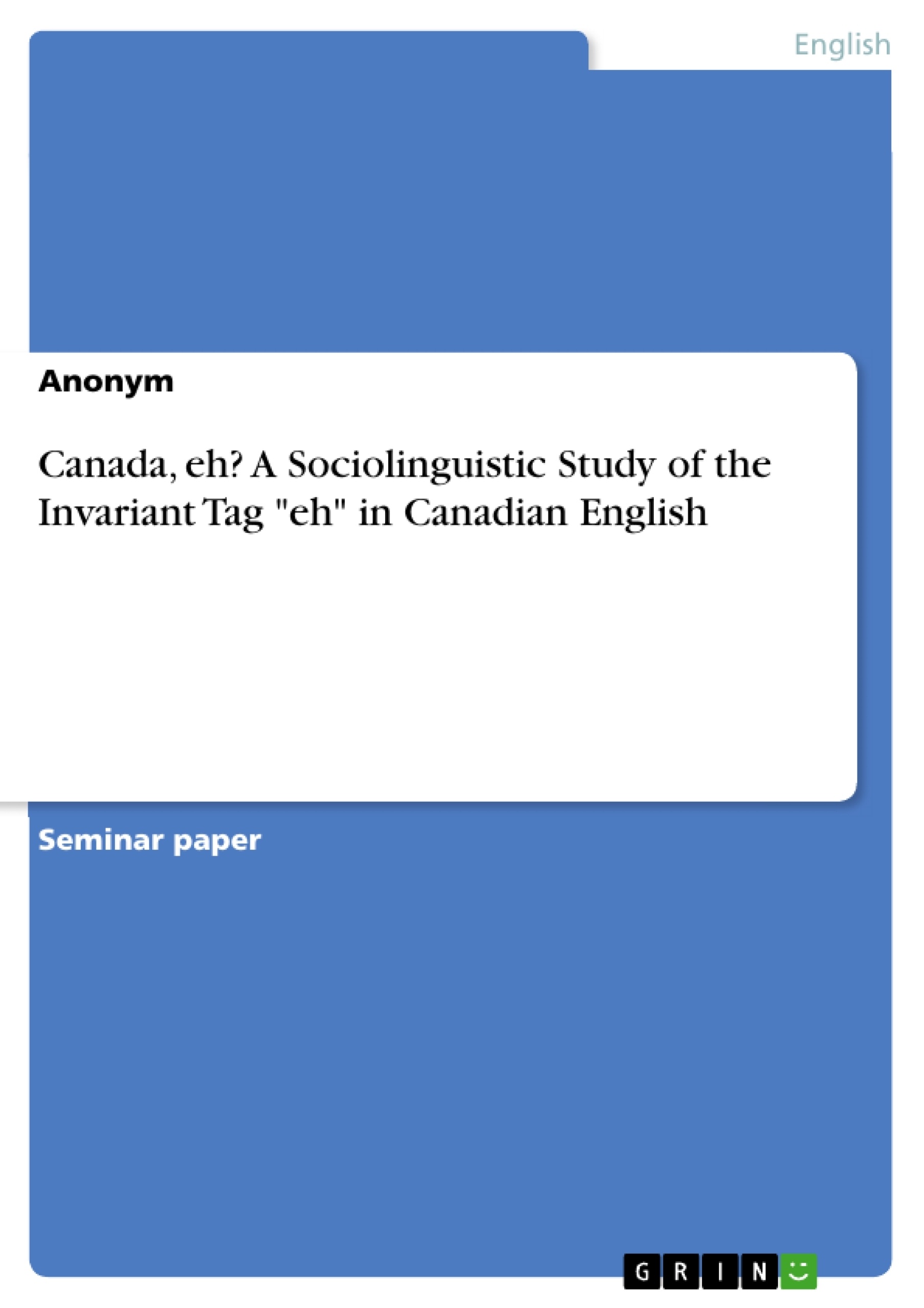The invariant tag "eh" is regarded as characteristic of Canadian English, although the usage of "eh" is similarly common in varieties of English outside of Canada, such as British, Australian and New Zealand English. However, despite its status as a typical marker of Canadian English, there is comparatively little research about its usage and specific functions. Nevertheless, it can be assumed that there are considerable discrepancies in the use of the invariant tag "eh" as recent research points to differences in terms of register as well as the age of the speaker. In fact, "eh" is often associated with vernacular Canadian English and, furthermore, appears to be in decline among younger speakers. Accordingly, it is more likely used as well as accepted in less formal settings and by a comparatively older speech community.
Therefore, this paper seeks to specifically examine the contemporary usage of "eh" with regard to the assumed differences in register and age of the speakers by means of an empirical study. On the basis of a questionnaire that draws on Gold’s 2004 Toronto survey, the variation in the use of eh is investigated among a relatively heterogeneous group of Canadian English speakers. Thereby, the differentiation between using "eh" in a formal and informal setting is also included as this paper aims at analyzing the differences in terms of the perceived formality of the various types in particular.
However, in order to provide an understanding of the diverse communicative functions of this invariant tag as well as to emphasize significant differences in the usage of and attitude towards "eh", the main findings of recent literature are presented at first. Subsequently, the methodology of this study as well as the development and distribution of the designed questionnaire are elucidated. The main part then illustrates the results of the survey and compares them with findings of earlier studies, such as Gold’s 2004 survey, which consisted of similar questions but did not cover the differences in register and age.
Inhaltsverzeichnis (Table of Contents)
- 1. INTRODUCTION
- 2. RECENT LITERATURE AND FINDINGS ON EH IN CANADIAN ENGLISH
- 2.1. COMMUNICATIVE FUNCTIONS OF THE INVARIANT TAG EH
- 2.2. DIFFERENCES IN THE USAGE AND ATTITUDES
- 3. METHODOLOGY AND AIMS OF THE STUDY
- 4. ANALYSIS OF FINDINGS
- 4.1. OVERALL RESULTS OF THE SURVEY
- 4.2. DIFFERENCES IN REGISTER AND AGE
- 4.3. COMPARISON WITH EARLIER STUDIES ON THE USAGE OF EH
- 4.4. SUMMARY OF THE FINDINGS
- 5. CONCLUSION
- 6. REFERENCES
Zielsetzung und Themenschwerpunkte (Objectives and Key Themes)
This paper aims to examine the contemporary usage of the invariant tag eh in Canadian English, focusing on assumed differences in register and age of speakers. It investigates how eh is used in both formal and informal settings, comparing its usage amongst various age groups. The study utilizes a questionnaire based on Gold's 2004 Toronto survey, analyzing a heterogeneous group of Canadian English speakers. Key themes and main ideas explored in the paper include:- The communicative functions of the invariant tag eh in Canadian English.
- Differences in the usage and attitudes towards eh based on register, age, and socioeconomic factors.
- Comparison of the present findings with earlier studies on eh usage, highlighting potential shifts in its use over time.
- The role of eh as a marker of vernacular Canadian English and its association with different social groups.
- The influence of sociolinguistic factors on the use and perception of eh.
Zusammenfassung der Kapitel (Chapter Summaries)
- Chapter 1: Introduction - This chapter introduces the invariant tag eh as a characteristic feature of Canadian English, highlighting the need for further research on its usage and functions. It outlines the paper's objective to examine contemporary usage patterns, specifically focusing on differences in register and age, through an empirical study based on a questionnaire.
- Chapter 2: Recent Literature and Findings on eh in Canadian English - This chapter reviews existing literature on the usage and attitudes towards eh in Canadian English, focusing on its communicative functions and the influence of sociolinguistic factors. It highlights the work of Elaine Gold's 2004 survey on eh usage among University of Toronto students, emphasizing the variation in its use across different types of eh.
- Chapter 2.1: Communicative Functions of the Invariant Tag eh - This section delves deeper into the communicative functions of eh, drawing on previous research by Gibson and Columbus. It explores how eh functions as a discourse marker, expressing different meanings depending on the communicative situation. The section also outlines various categories of eh usage identified by Gold, revealing the diverse meanings conveyed by this invariant tag.
- Chapter 2.2: Differences in the Usage and Attitudes - This section examines the sociolinguistic factors that influence the usage and attitudes towards eh. It discusses the role of regional differences, socioeconomic aspects, age, and sex in shaping its distribution. The section also explores how eh can be perceived differently depending on its specific use, highlighting its potential association with negative stereotypes.
Schlüsselwörter (Keywords)
The paper focuses on the invariant tag eh in Canadian English, exploring its communicative functions, usage patterns, and the influence of sociolinguistic factors, including register, age, and socioeconomic status. Key terms and concepts include discourse markers, sociolinguistics, Canadian English, vernacular speech, and pragmatic functions. The study also delves into the perceived formality and social connotations associated with different types of eh usage.- Quote paper
- Anonym (Author), 2018, Canada, eh? A Sociolinguistic Study of the Invariant Tag "eh" in Canadian English, Munich, GRIN Verlag, https://www.grin.com/document/509918



